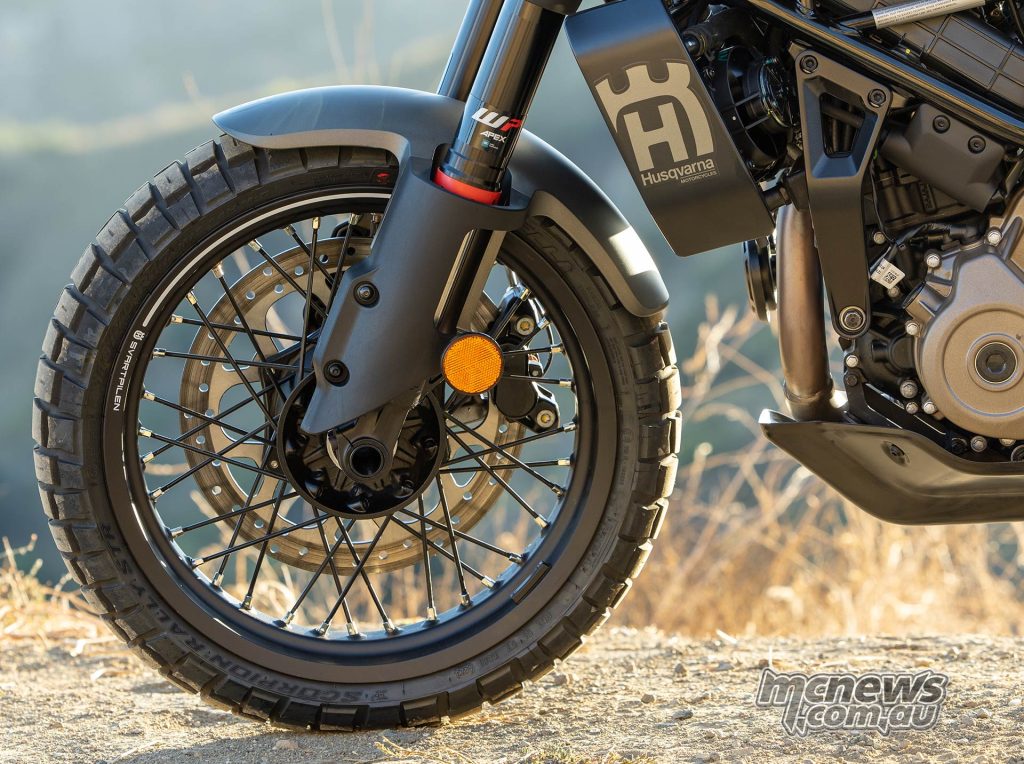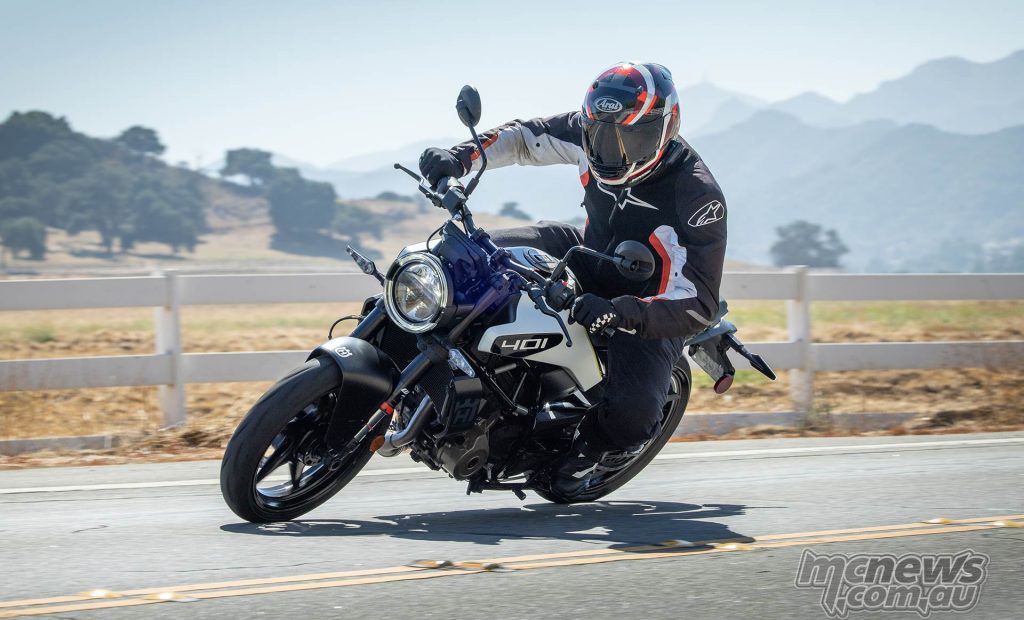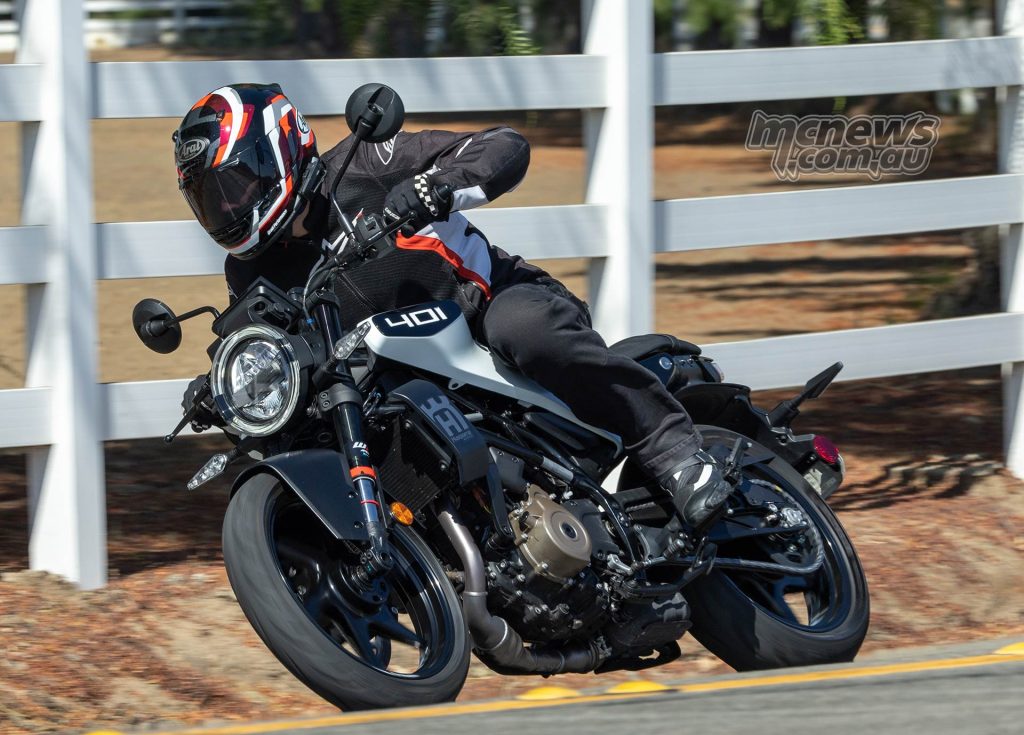Husqvarna Svartpilen and Vitpilen 401 Review
Test by Rennie Scaysbrook
For a company that seems to be updating its model line-up every six months, it seems odd we’re talking about six full years since the KTM-endowed Husqvarna Vitpilen 401 and Svartpilen 401 models received any significant changes.

Released in 2018 as a modern take on the café racer/scrambler scene that was positively booming at the time, the Vitpilen 401 and Svartpilen 401 have been solid performers for the company, whose logo famously depicts a gun sight viewed from the end of the barrel.

Essentially, everything you see before you on the $8795 ride-away Svartpilen and Vitpilen 401 is revised for 2024. Some heavily, some not so much, but it’s pretty much all-new. The hardware between the Vit and the Svart is the same, so we’ll dive into the bones first before discussing the differences.
The chassis is revised substantially, and the new model is wider and lighter than in pre-2024 guise. It’s still created using the company’s trademark steel trellis design, however, engineers have offset the rear shock absorber to the right side of the chassis to allow for a larger airbox and the revised, lighter subframe that was redesigned with the extra benefit of increased passenger comfort.

The shock bolts directly to a new, curved/semi-banana style swingarm, redesigned to be a touch more rigid than before and to allow for the placement of the redesigned exhaust muffler that exits under the right rear of the motor.
The new shock gives the Vit/Svartpilen an edgy look, and forms a perfect line between the side-frame spars and swingarm itself, while the under-engine muffler cleans up the rear of the bike substantially. You’ll be able to get countless aftermarket pipes soon enough if you really, really want the traditional muffler that exits up the right rear of the bike.

The suspension has been altered in the 43mm WP APEX open-cartridge fork that now has only five stages of rebound and compression damping, thus ensuring noticeable differences between each click of the…err, clickers at the top of the fork, but there’s no preload adjustment available on the front.
At the rear, the WP APEX monoshock, now all glammed up in its 45° right-side angle for all to see, runs a progressive spring, so it’s softer at the start of the stroke before ramping up as more travel is used. This is a carryover from the old model, but still worth noting. Control of the shock is the same as before as well, with preload and rebound damping adjustment, but not compression damping.

For bikes with vastly different tyres — the Svartpilen runs Pirelli Scorpion Rally 50/50 tires for its scrambler look while the Vitpilen runs the Michelin Power 6 sportbike tyres — the two bikes handle remarkably similarly.
Both have a fluidity to the steering that belies their varying designations, although the Svartpilen is definitely the most adaptable of the two, as you can hustle it along the tarmac just as fast as you can on the Vitpilen, but if you tried to do the same on dirt with the Vitpilen, you’d quickly end up on your head.

The Vitpilen has morphed into more of a mini-streetfighter, thanks to its use of the new one-piece handlebar, Husqvarna doing away with the café racer-style clip-on handlebars the original model came out with in 2018.
That’s given the Vitpilen rider a little more comfort for longer rides, although I think you’d be limited to 45-minutes at a time, as that single-piece seat becomes rather hard after any longer than that.

Cranking up the preload on both bikes will be a must for any rider north of 90 kg (such as myself), which is easy thanks to the stepped adjuster that’s far simpler to use than the traditional lock and collar design that requires a hammer and screwdriver.

Get the preload sorted and both bikes handle beautifully, especially if you keep speeds to a so called “reasonable” level. The Svartpilen tips the scales at 5.5 kg more (154.5 kg vs 159 kg) than the Vitpilen, and although that weight is certainly noticeable at speed, you’ve got more comfort on your side thanks to the slightly different seat and raised handlebar (and besides, 159 kg), it is still pretty miniscule for a street motorcycle these days.

The steering geometry between both the Vit and Svart are identical, with the same rake, trail, triple-clamp off-set, and wheelbase, as well as the same single-side ByBre four-piston radial-mount caliper gripping a 320 mm disc rotor up front, while the single-piston rear brake clamps down on a larger 240 mm disc.
Braking aid is the domain of the Bosch 9.3 MP two-channel ABS system that houses a Supermoto Mode so you can get all sendy with it, so long as you know how to bring the chassis back from a 45° slide. For normal people, there’s the added safety net of the brakes, being Cornering ABS-equipped via the three-stage (not six) Inertial Measurement Unit, one that also facilitates the two-stage traction control’s intervention.

Another little addition, done purely for design purposes, was for the engineers to move the front disc and caliper to the right side of the machine to keep the left side rather sparse-looking.
There’s another crucial part that’s identical between the bikes — the motor. This is a very similar (very similar) single-cylinder, 399 cc LC4 power unit found in another of KTM’s products. Hint: we tested it here: https://www.mcnews.com.au/2024-ktm-390-duke-review-motorcycle-test/ that produces 44 hp and 27 lb-ft of torque.

The LC4’s larger airbox mates to a reworked fuel injector and 46 mm Doll’Orto throttle body, there’s four new camshafts, reworked DLC (Diamond-Like Coating) cam levers, a new piston, crankshaft, and gearbox that links to a new quickshifter (Husqvarna calls it Easy Shift), and the PASC (Power-Assisted Slipper Clutch) houses slightly heavier springs to improve power transfer from the engine to the gearbox.
Also new is the LC4’s employment of a ride-by-wire throttle, which allows the use of two different throttles in Road and Rain.

At speed, the LC4 is a gem of a motor. It’s funny how much I crap on about bikes being strangled via emissions regulations, especially when in that transition between bottom-end to mid-range, but the LC4 seems to suffer less here than many twin-cylinder bikes twice its size.

It produces more than ample performance to keep up with any level of freeway traffic and enjoys a ripping top-end that makes you question if you’ve got more than just one piston beneath you. Plus, having a counter-balancer built into the motor takes out much of the vibrations inherent with a single-cylinder out on the street.

I did, however, endure some fairly drastic differences between the Vitpilen and Svartpilen in terms of shifting. The latter’s Easy Shift seemingly to have taken an Easy Shit and thus it would only work in the top three gears. I suspect that is more to do with a software glitch on my personal testbike, so I wouldn’t worry about that if you’re considering either bike.
Within the cockpit, you’ve got a new five-inch TFT display that runs turn-by-turn navigation through the Husqvarna app in a similar vein to what company owner KTM have done with its Duke range.

It’s a simple thing to navigate, a task which in itself isn’t simple to pull off because creating a good user experience seems to be a task some get right rather easily, while others can’t do to save their lives. KTM/Husqvarna have been at the TFT longer than a lot of manufactures, so they’ve had plenty of time to get it right, and it appears they’ve done so.

There’s no cruise control on either the Vitpilen or Svartpilen, but they have implemented a new speed-limiter function, one that acts almost like a pitlane speed limiter where a set speed is determined and the bike will not go faster, no matter what happens at the throttle. It’ll prove ultra-handy in built-up areas with speed cameras or, if you’re from Europe or Australia, in those bastard average speed camera areas.

Aesthetically, there’s minimal touches of difference between this year’s Svart and Vit models. There’s a slight extension in the back of the seat, new colours, and graphics on the Vitpilen, with the Svartpilen getting slightly reworked ergos to go with the new subframe and seat, but at first glance both look quite similar to their outgoing predecessors.

But the reworking of the platform has resulted in two very capable machines, ones with that quirky Husqvarna edge worked into it. And considering the $8795 ride-away price, they represent excellent value in a market where the price of everything just keeps going up.

2024 Husqvarna Vitpilen & Svartpilen 401 Specifications
| 2024 Husqvarna Vitpilen and Svartpilen 401 Specifications | |
| Engine | 398.6 cc Four-stroke, single-cylinder |
| Bore x Stroke | 89 x 64 mm |
| Power | 45 hp (33 kW) |
| Torque | 39 Nm |
| Cooling – | Liquid |
| Driveline | Six-speed, slip-assist clutch, Chain |
| EMS | Bosch with RBW, Road/Rain modes, MTC (Cornering) |
| ABS | Bosch 9.3 MP (Cornering and Supermoto) |
| Front Brakes | 320 mm single disc, ByBre four-piston caliper |
| Rear Brake | 240 mm single disc |
| Front Suspension | WP Apex 43 forks, 150 mm travel, compression/rebound adjustable |
| Rear Suspension – | WP Apex Monoshock, 150 mm travel, preload/rebound adjustable |
| Ground Clearance | 180 mm |
| Seat Height | 820 mm |
| Frame | Steel trellis |
| Steering Head Angle | 66-degrees |
| Fuel Tank | 13.5 Litres |
| Weight without fuel | 154.5 kg (159 kg for Svartpilen) |
| RRP | $8795 ride-away |
Husqvarna Svartpilen and Vitpilen 401 Gallery
Images by Kevin Wing




































































































